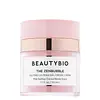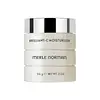What's inside
What's inside
 Key Ingredients
Key Ingredients

 Benefits
Benefits

 Concerns
Concerns

 Ingredients Side-by-side
Ingredients Side-by-side

Water
Skin ConditioningGlycerin
HumectantDimethicone
EmollientButylene Glycol
HumectantDiphenylsiloxy Phenyl Trimethicone
Skin ConditioningMicrocrystalline Cellulose
AbsorbentPEG-9 Polydimethylsiloxyethyl Dimethicone
EmulsifyingPolymethylsilsesquioxane
Chamomilla Recutita Flower Extract
MaskingChlorella Vulgaris Extract
Skin ConditioningCentella Asiatica Extract
CleansingTocopherol
AntioxidantSaccharide Isomerate
HumectantCaprylyl Glycol
EmollientDimethicone/Phenyl Vinyl Dimethicone Crosspolymer
Dimethicone/PEG-10/15 Crosspolymer
Dipropylene Glycol
HumectantDisodium EDTA
Cellulose Gum
Emulsion StabilisingLactic Acid
BufferingPropanediol
SolventChlorphenesin
AntimicrobialPhenoxyethanol
PreservativeSodium Citrate
BufferingSodium Chloride
MaskingWater, Glycerin, Dimethicone, Butylene Glycol, Diphenylsiloxy Phenyl Trimethicone, Microcrystalline Cellulose, PEG-9 Polydimethylsiloxyethyl Dimethicone, Polymethylsilsesquioxane, Chamomilla Recutita Flower Extract, Chlorella Vulgaris Extract, Centella Asiatica Extract, Tocopherol, Saccharide Isomerate, Caprylyl Glycol, Dimethicone/Phenyl Vinyl Dimethicone Crosspolymer, Dimethicone/PEG-10/15 Crosspolymer, Dipropylene Glycol, Disodium EDTA, Cellulose Gum, Lactic Acid, Propanediol, Chlorphenesin, Phenoxyethanol, Sodium Citrate, Sodium Chloride
Water
Skin ConditioningHydrogenated Polydecene
EmollientAlcohol Denat.
AntimicrobialGlycerin
HumectantDipropylene Glycol
HumectantCetyl PEG/PPG-10/1 Dimethicone
EmulsifyingButylene Glycol
HumectantAscorbyl Glucoside
AntioxidantTocopheryl Acetate
AntioxidantHydrolyzed Soy Protein
HumectantGlycyrrhiza Glabra Root Extract
BleachingMorus Bombycis Root Extract
Skin ConditioningScutellaria Baicalensis Root Extract
AstringentSaxifraga Sarmentosa Extract
Skin ConditioningVitis Vinifera Fruit Extract
Skin ConditioningCucumis Sativus Fruit Extract
EmollientCamellia Sinensis Leaf Extract
AntimicrobialSodium Hyaluronate
HumectantLecithin
EmollientHydrogenated Polyisobutene
EmollientDimethicone
EmollientPetrolatum
EmollientPolymethylsilsesquioxane
PEG-20
HumectantPEG-150
HumectantPalmitoyl Hydroxypropyltrimonium Amylopectin/Glycerin Crosspolymer
Skin ConditioningPropylene Glycol
HumectantDisodium EDTA
Citric Acid
BufferingSodium Chloride
MaskingPotassium Hydroxide
BufferingSodium Citrate
BufferingPhenoxyethanol
PreservativeMethylparaben
PreservativePropylparaben
PreservativeMica
Cosmetic ColorantCI 77891
Cosmetic ColorantWater, Hydrogenated Polydecene, Alcohol Denat., Glycerin, Dipropylene Glycol, Cetyl PEG/PPG-10/1 Dimethicone, Butylene Glycol, Ascorbyl Glucoside, Tocopheryl Acetate, Hydrolyzed Soy Protein, Glycyrrhiza Glabra Root Extract, Morus Bombycis Root Extract, Scutellaria Baicalensis Root Extract, Saxifraga Sarmentosa Extract, Vitis Vinifera Fruit Extract, Cucumis Sativus Fruit Extract, Camellia Sinensis Leaf Extract, Sodium Hyaluronate, Lecithin, Hydrogenated Polyisobutene, Dimethicone, Petrolatum, Polymethylsilsesquioxane, PEG-20, PEG-150, Palmitoyl Hydroxypropyltrimonium Amylopectin/Glycerin Crosspolymer, Propylene Glycol, Disodium EDTA, Citric Acid, Sodium Chloride, Potassium Hydroxide, Sodium Citrate, Phenoxyethanol, Methylparaben, Propylparaben, Mica, CI 77891
 Reviews
Reviews

Ingredients Explained
These ingredients are found in both products.
Ingredients higher up in an ingredient list are typically present in a larger amount.
Butylene Glycol (or BG) is used within cosmetic products for a few different reasons:
Overall, Butylene Glycol is a safe and well-rounded ingredient that works well with other ingredients.
Though this ingredient works well with most skin types, some people with sensitive skin may experience a reaction such as allergic rashes, closed comedones, or itchiness.
Learn more about Butylene GlycolDimethicone is a type of synthetic silicone created from natural materials such as quartz.
What it does:
Dimethicone comes in different viscosities:
Depending on the viscosity, dimethicone has different properties.
Ingredients lists don't always show which type is used, so we recommend reaching out to the brand if you have questions about the viscosity.
This ingredient is unlikely to cause irritation because it does not get absorbed into skin. However, people with silicone allergies should be careful about using this ingredient.
Note: Dimethicone may contribute to pilling. This is because it is not oil or water soluble, so pilling may occur when layered with products. When mixed with heavy oils in a formula, the outcome is also quite greasy.
Learn more about DimethiconeDipropylene Glycol is a synthetically created humectant, stabilizer, and solvent.
This ingredient helps:
Dipropylene glycol is technically an alcohol, but it belongs to the glycol family (often considered part of the ‘good’ alcohols). This means it is hydrating and gentle on skin unlike drying solvent alcohols like denatured alcohol.
As a masking agent, Dipropylene Glycol can be used to cover the smell of other ingredients. However, it does not have a scent.
Studies show Dipropylene Glycol is considered safe to use in skincare.
Learn more about Dipropylene GlycolDisodium EDTA plays a role in making products more stable by aiding other preservatives.
It is a chelating agent, meaning it neutralizes metal ions that may be found in a product.
Disodium EDTA is a salt of edetic acid and is found to be safe in cosmetic ingredients.
Learn more about Disodium EDTAGlycerin is already naturally found in your skin. It helps moisturize and protect your skin.
A study from 2016 found glycerin to be more effective as a humectant than AHAs and hyaluronic acid.
As a humectant, it helps the skin stay hydrated by pulling moisture to your skin. The low molecular weight of glycerin allows it to pull moisture into the deeper layers of your skin.
Hydrated skin improves your skin barrier; Your skin barrier helps protect against irritants and bacteria.
Glycerin has also been found to have antimicrobial and antiviral properties. Due to these properties, glycerin is often used in wound and burn treatments.
In cosmetics, glycerin is usually derived from plants such as soybean or palm. However, it can also be sourced from animals, such as tallow or animal fat.
This ingredient is organic, colorless, odorless, and non-toxic.
Glycerin is the name for this ingredient in American English. British English uses Glycerol/Glycerine.
Learn more about GlycerinPhenoxyethanol is a preservative that has germicide, antimicrobial, and aromatic properties. Studies show that phenoxyethanol can prevent microbial growth. By itself, it has a scent that is similar to that of a rose.
It's often used in formulations along with Caprylyl Glycol to preserve the shelf life of products.
Polymethylsilsesquioxane is a silicone used as a film forming agent.
When applied to the skin, this ingredient creates an invisible film on the surface. This film still allows oxygen to pass through, but prevents moisture from escaping. This can help condition and hydrate the skin. It also leaves a silky feel when applied.
Polymethylsilsesquioxane has not been shown to clog pores. It has been deemed safe to use up to 55%, but most cosmetics use much less.
If you have concerns about using this ingredient, we recommend speaking with a professional.
Learn more about PolymethylsilsesquioxaneChances are, you eat sodium chloride every day. Sodium Chloride is also known as table salt.
This ingredient has many purposes in skincare: thickener, emulsifier, and exfoliator.
You'll most likely find this ingredient in cleansers where it is used to create a gel-like texture. As an emulsifier, it also prevents ingredients from separating.
There is much debate on whether this ingredient is comedogenic. The short answer - comedogenic ratings don't tell the whole story. Learn more about comegodenic ratings here.
The concensus about this ingredient causing acne seems to be divided. Research is needed to understand if this ingredient does cause acne.
Scrubs may use salt as the primary exfoliating ingredient.
Learn more about Sodium ChlorideSodium Citrate is the sodium salts of citric acid. In skincare, it is used to alter pH levels and acts as a preservative.
Its main functions are to maintain the pH of a product and neutralize metal ions.
The acidity of our skin is maintained by our glands and skin biome; normal pH level of skin is slightly acidic (~4.75-5.5).
Being slightly acidic allows our skin to create an "acid mantle". This acid mantle is a thin barrier that protects our skin from bacteria and contaminants.
Learn more about Sodium CitrateWater. It's the most common cosmetic ingredient of all. You'll usually see it at the top of ingredient lists, meaning that it makes up the largest part of the product.
So why is it so popular? Water most often acts as a solvent - this means that it helps dissolve other ingredients into the formulation.
You'll also recognize water as that liquid we all need to stay alive. If you see this, drink a glass of water. Stay hydrated!
Learn more about Water